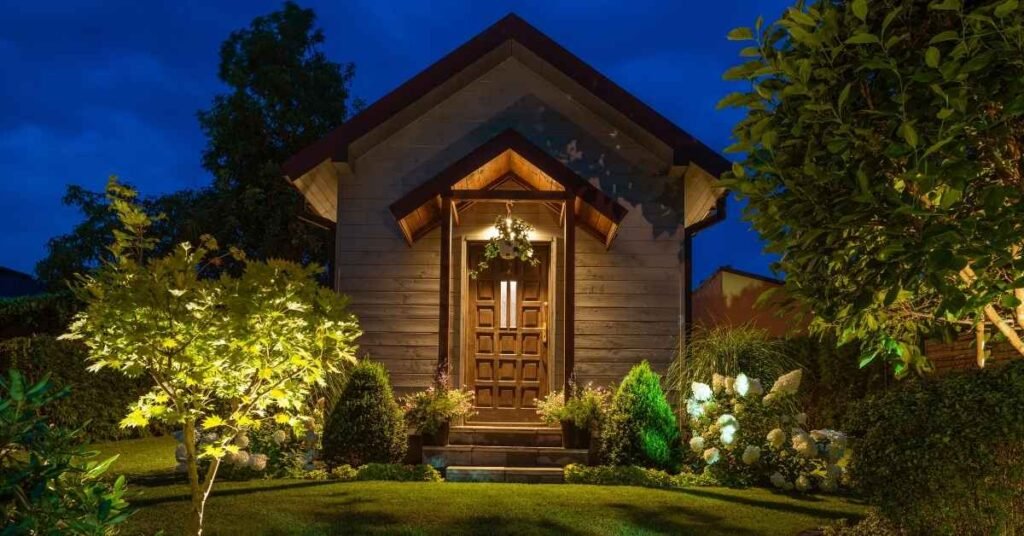Backyard Garden Lighting: Illuminate Your Outdoor Space
Table of Contents
Introduction: The Impact of Garden Lighting
Garden lighting plays a transformative role in enhancing outdoor spaces’ aesthetics and functionality. Beyond merely illuminating pathways, strategically placed lights can highlight architectural features, showcase plant beauty, and create inviting atmospheres for evening gatherings. Adequate garden lighting extends the usability of outdoor areas into the night and adds a layer of security by illuminating dark corners and potential hazards.

Modern lighting options, including LED fixtures and innovative controls, offer energy efficiency and versatility, allowing customized lighting schemes that adjust to various moods and occasions. By thoughtfully integrating garden lighting, homeowners can elevate their outdoor environments, blending practicality with visual appeal and creating a welcoming space that shines day and night.
Types of Garden Lighting
Garden lighting comes in various types, each offering distinct benefits and suited to different needs. Understanding these options helps you select the proper lighting to enhance your outdoor space.
Solar Lighting
Solar garden lights harness energy from the sun, making them an eco-friendly and cost-effective choice. They are easy to install with no wiring required, as they operate on rechargeable batteries charged during the day. Solar lights are ideal for pathways, garden beds, and accentuating features like statues or shrubs. They are best used in areas with adequate sunlight for optimal performance and are available in various styles, from stake lights to lanterns.
LED Lighting
LED lights are known for their energy efficiency, long lifespan, and bright illumination. They are available in various forms, including spotlights, floodlights, and string lights. LEDs are suitable for highlighting focal points like water features or architectural details and are often used with other lighting types for a layered effect. Their low heat output and minimal energy consumption make them an excellent choice for sustainable and long-term garden lighting solutions.
Low Voltage Options
Low-voltage lighting systems operate at 12 volts and require a transformer to reduce the standard 120-volt current. This type of lighting is more versatile and safer for outdoor use than high-voltage systems. Low-voltage lights are suitable for more extensive gardens and can be used for path, accent, and underwater pond lighting. They offer installation flexibility and can be adjusted to achieve the desired lighting effect.
Choosing the Right Lighting for Different Areas
To optimize garden lighting, consider the function and aesthetics of each area. For pathways and driveways, choose solar or low-voltage lights that provide consistent illumination and enhance safety. LED spotlights or low-voltage uplights offer focused and adjustable lighting for highlighting plants or garden features. Ambient lighting, such as string lights or lanterns, creates a warm and inviting atmosphere for seating areas and outdoor gatherings. By selecting the appropriate type of lighting for each area, you can create a beautifully lit, functional, and visually appealing garden.
DIY Garden Lighting Projects
DIY garden lighting projects can significantly enhance outdoor space, adding functionality and charm. Two popular and accessible projects are installing pathway lights and creating ambient lighting with string lights.
Installing Pathway Lights
Pathway lights not only illuminate walkways for safety but also add visual appeal. Start by choosing solar or low-voltage lights for ease of installation. Solar lights are particularly DIY-friendly as they require no wiring and are powered by sunlight. Begin by planning the layout, ensuring even spacing along the path for consistent illumination. Use a shovel or a garden trowel to create tiny holes where the lights will be installed.
For solar lights, insert the stakes into the ground; for low-voltage lights, you may need to bury a cable leading from the transformer to each light. Ensure the transformer is placed in a dry, accessible location. Position the lights to avoid obstructing the view and effectively highlight the path. Once installed, check the lights at night to ensure proper illumination and adjust as needed.
Creating Ambient Lighting with String Lights
String lights are an excellent way to create a cozy and enchanting atmosphere in your garden. Start by selecting a string light type for outdoor use, such as LED or weather-resistant bulbs. Choose a design that complements your garden’s aesthetic, whether fairy lights, globe lights, or festoon lights. Decide where you want the lights to be hung, such as along fences, tree branches, or pergolas. Use outdoor extension cords if necessary and ensure all connections are secure. Drape the lights loosely or wrap them around posts and railings for a whimsical effect.
Consider incorporating dimmers or timers to control the brightness and duration to enhance the look. String lights can transform an ordinary garden into a magical retreat, perfect for evening gatherings or relaxation. Both DIY projects are manageable and provide immediate visual and functional benefits, enhancing your garden’s beauty and usability with minimal effort.
Designing a Garden Lighting Plan
Designing a garden lighting plan requires a thoughtful approach to ensure both functionality and aesthetics are achieved. You can create a visually stunning and practical outdoor space by highlighting key features and balancing these elements.
Highlighting Key Features
Begin by identifying the garden’s focal points that you wish to emphasize, such as architectural elements, water features, sculptures, or unique plants. Use different lighting techniques to bring these features into the spotlight. For example, spotlights or floodlights can be positioned to cast dramatic illumination on a tree or a statue. At the same time, up-lights can accentuate the texture of walls or the canopy of a large shrub.
Down-lighting can create a soft, moonlit effect, perfect for highlighting ground cover plants or pathways. Consider backlighting for an ethereal glow around structures or plants, adding depth and dimension. Properly planned, these techniques enhance the garden’s visual appeal, drawing attention to its most impressive elements.
Balancing Functionality and Aesthetics
While highlighting features is essential, ensuring the garden is functional and safe is equally crucial. Pathway lights are critical for guiding movement and preventing trips and falls, while floodlights or security lights can provide safety and visibility around entrances and darker areas. To balance functionality with aesthetics, integrate dimmable lights or bright lighting systems that allow for adjustments based on the time of day or occasion. Incorporate ambient lighting to create a warm, inviting atmosphere for seating areas and outdoor entertainment spaces.
By thoughtfully combining these elements, you can craft a garden lighting plan that showcases your garden’s beauty and serves practical purposes. The key is to blend these aspects harmoniously, ensuring your garden is beautiful and functional, inviting you to enjoy its splendor day and night.

Maintaining Your Garden Lighting
Maintaining garden lighting is essential to ensure that it operates efficiently and continues to enhance your outdoor space effectively. Regular upkeep involves cleaning and replacing bulbs and ensuring safety and efficiency.
Cleaning and Replacing Bulbs
Routine cleaning is crucial for maintaining the performance and appearance of garden lights. Dust, dirt, and algae can accumulate on fixtures, reducing their brightness and clarity. Use a soft cloth and a mild detergent to gently clean the surfaces of your lights, avoiding abrasive materials that could scratch or damage them. For solar lights, remove the solar panels and clean them with a damp cloth to ensure they can effectively charge during the day.
Replacing bulbs is another important aspect of maintenance. Check your lights periodically to see if any bulbs have burned out or are dimming. For traditional incandescent or LED bulbs, follow the manufacturer’s guidelines for replacement. Ensure the power is turned off before replacing bulbs to avoid electrical hazards. For solar lights, replace the rechargeable batteries as needed, typically every 1-2 years, to maintain optimal performance.
Ensuring Safety and Efficiency
Safety is paramount when maintaining garden lighting. Regularly inspect wiring and connections for wear, fraying, or damage. For low-voltage or wired systems, ensure all connections are secure and protected from water damage. Ground fault circuit interrupters (GFCIs) should be used to reduce the risk of electrical shock.
Efficiency can be improved by using energy-efficient lighting options, such as LEDs or solar lights, which consume less power and have longer lifespans. Ensure that outdoor lights are correctly installed and angled to minimize light pollution and direct light where needed most. Consider using timers or smart controls to manage lighting schedules, reducing unnecessary usage and saving energy. By adhering to these maintenance practices, you can keep your garden lighting in excellent condition, ensuring it remains functional and beautiful while promoting safety and efficiency.
Conclusion: Transforming Your Garden with Light
Transforming your garden with light is a powerful way to enhance its beauty and functionality. Thoughtful lighting design can highlight key features, create inviting atmospheres, and extend the usability of your outdoor space into the evening. You can achieve a harmonious blend of aesthetics and practicality by selecting appropriate lighting types whether solar, LED, or low voltage and integrating innovative solutions like smart controls.
Regular maintenance, including cleaning and replacing bulbs, ensures your lighting remains effective and safe. Balancing these elements elevates your garden’s visual appeal and makes it a more enjoyable and functional space. With well-planned lighting, you can create a captivating garden environment that shines brightly, showcasing its charm and inviting you to savor its beauty day and night.
